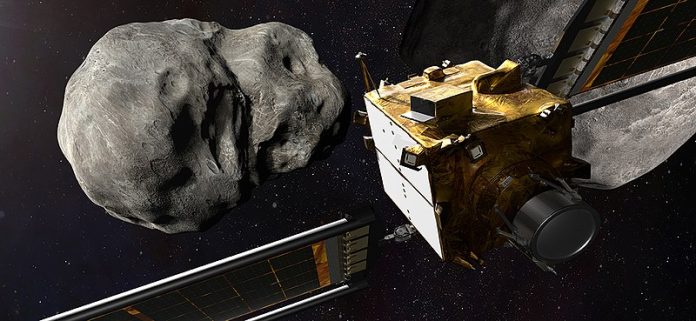In the last 500 million years, there have been at least five episodes of mass extinctions of life-forms on the Earth when more than three-quarters of the existing species got eliminated. The last such large-scale life extinction occurred due to asteroid impact about 65 million years ago in Cretaceous period. The resulting conditions led to the elimination of dinosaurs from the face of Earth.
Near-Earth objects (NEOs) such as asteroids and comets, i.e., the objects that passes close to the Earth’s orbit are potentially hazardous. Planetary defence is about detecting and mitigating threats of impact from the NEOs. Deflecting an asteroid away from the Earth is one way to do this.
Double Asteroid Redirection Test (DART) was the first-ever mission dedicated to changing an asteroid’s motion in space through kinetic impact. It was demonstration of kinetic impactor technology viz., impacting an asteroid to adjust its speed and path.
DART’s target was the binary asteroid system comprising of the larger asteroid Didymos and the smaller asteroid, Dimorphos which orbits the larger asteroid. It was suitable candidate for first planetary defence experiment, although it is not on a path to collide with Earth and poses no actual threat.
The DART spacecraft impacted asteroid Dimorphos on 26 September 2022. It showed that a kinetic impactor could deflect away a hazardous asteroid on a collision course with Earth.
A study published on 19 March 2024 reports that the impact changed both orbit and shape of Dimorphos. The orbit is no longer circular, and the orbital period is 33 minutes and 15 seconds shorter. The shape has changed from relatively symmetrical “oblate spheroid” to a “triaxial ellipsoid” like an oblong watermelon.
The research team used three data sources in their computer models to deduce aftereffects of impact on the asteroid.
- Images captured by DART spacecraft: Images captured by the spacecraft as it approached the asteroid and sent them back to Earth via NASA’s Deep Space Network (DSN). These images provided close-up measurements of the gap between Didymos and Dimorphos while also gauging the dimensions of both asteroids just prior to impact.
- Radar observations: DSN’s Goldstone Solar System Radar bounced radio waves off both asteroids to precisely measure the position and velocity of Dimorphos relative to Didymos after impact.
- The third source of data was provided by the ground telescopes around the world that measured both asteroids’ “light curve,” or how the sunlight reflecting off the asteroids’ surfaces changed over time. By comparing the light curves before and after impact, the researchers could learn how DART altered Dimorphos’ motion.
As Dimorphos orbits, it periodically passes in front of and then behind Didymos. In these so-called “mutual events,” one asteroid can cast a shadow on the other, or block our view from Earth. In either case, a temporary dimming – a dip in the light curve – will be recorded by telescopes.
The research team used the timing of this precise series of light-curve dips to deduce the shape of the orbit and figured out the shape of the asteroid. The team found Dimorphos’ orbit is now slightly elongated, or eccentric.
The researchers also calculated how Dimorphos’ orbital period evolved. Immediately after impact, DART reduced the average distance between the two asteroids, shortening Dimorphos’ orbital period by 32 minutes and 42 seconds, to 11 hours, 22 minutes, and 37 seconds. Over the following weeks, the asteroid’s orbital period continued to shorten as Dimorphos lost more rocky material to space, finally settling at 11 hours, 22 minutes, and 3 seconds per orbit – 33 minutes and 15 seconds less time than before impact.
Dimorphos now has a mean orbital distance from Didymos of about 3,780 feet (1,152 meters) – about 120 feet (37 meters) closer than before impact.
The forthcoming Hera mission (to be launched in 2024) of ESA will travel to the binary asteroid system to carry out a detailed survey and confirm how DART reshaped Dimorphos.
***
References:
- NASA. News – NASA Study: Asteroid’s Orbit, Shape Changed After DART Impact. Posted 19 March 2024. Available at https://www.jpl.nasa.gov/news/nasa-study-asteroids-orbit-shape-changed-after-dart-impact
- Naidu S.P., et al 2024. Orbital and Physical Characterization of Asteroid Dimorphos Following the DART Impact. The Planetary Science Journal, Volume 5, Number 3. Published 19 March 2024. DOI: https://doi.org/10.3847/PSJ/ad26e7
***






































